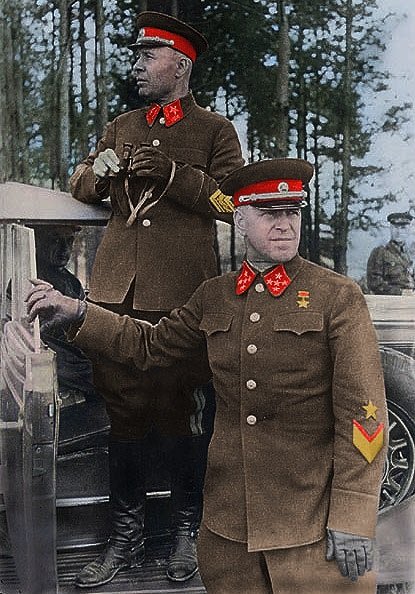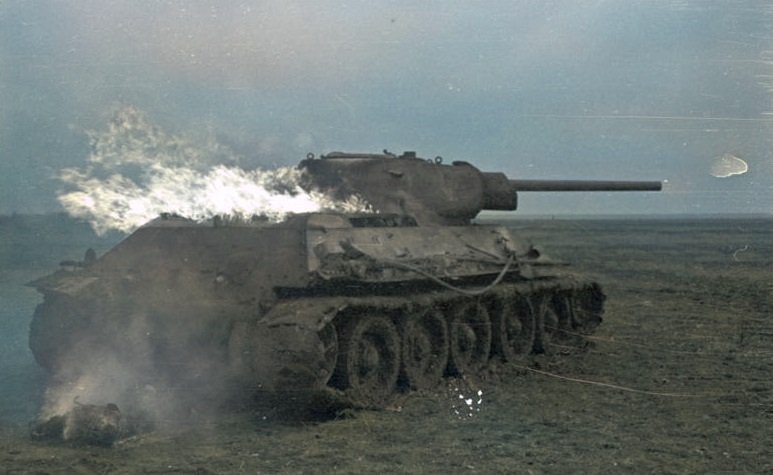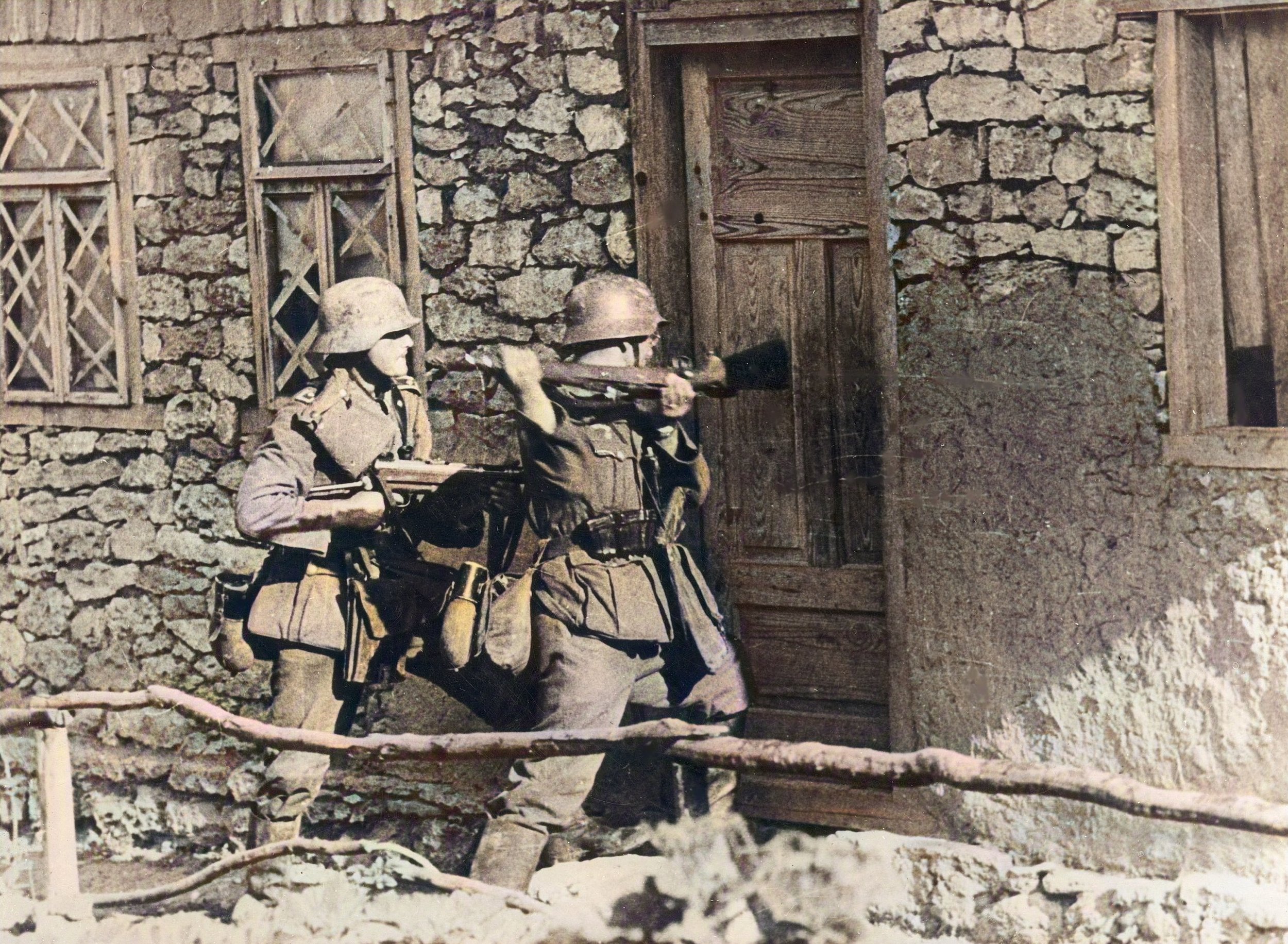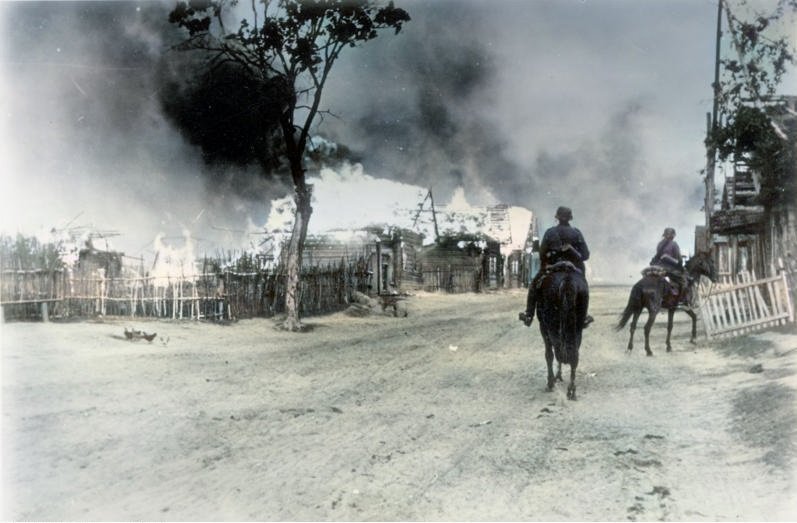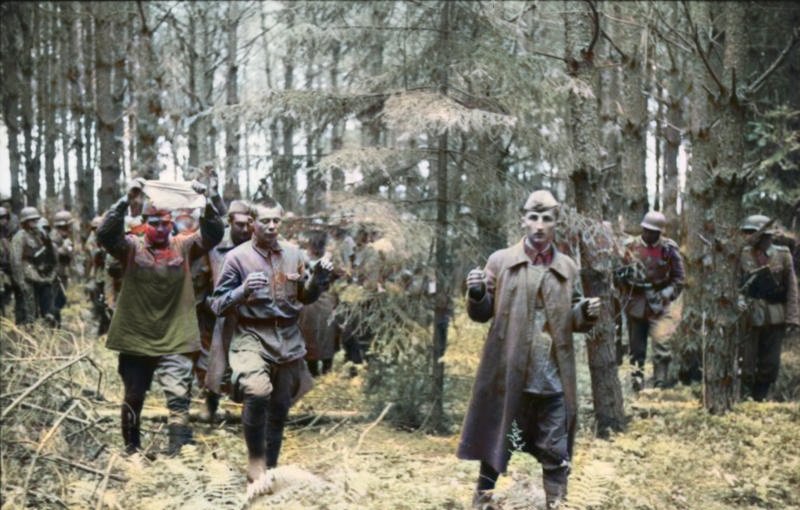Operation Barbarossa
Chapter 9
“German people!
At this moment, an attack unprecedented in the history of the world in its extent and size has begun. With Finnish comrades, the victors of Narvik stand by the Arctic Sea. German divisions, under the command of the conqueror of Norway, together with the heroes of Finland’s freedom and their marshal, defend Finnish soil. On the Eastern Front, German formations extend from East Prussia to the Carpathians. From the banks of the Pruth River, from the lower Danube to the Black Sea, German and Romanian soldiers are united under state leader Antonescu.
The purpose of this front is no longer the protection of the individual nations, but rather the safety of Europe, and therefore the salvation of everyone.
I have therefore decided today once again to put the fate of Germany and the future of the German Reich and our people in the hands of our soldiers.
May God help us in this battle”
German troops pass a Soviet border marker
At 0315 on June 22, 1941, the largest invasion in history commenced, as German artillery opened fire along the frontier with the Soviet Union. It would be followed by massive airstrikes against the bases of the Red Air Force, destroying the bulk of the VVS on the ground, and soon after would follow almost 3 million troops, invading along a front almost 2,000 miles long, stretching from along the Finnish border, and along the western border of the USSR from the Baltic down to the Black Sea. The combined Axis force consisted of German, Finnish, Romanian, Slovakian and Italian troops, with the Hungarians and Bulgarians soon to join in. This was to be the largest escalation of the war to date, and also would signify a marked shift in the way in which it was fought. Unlike the campaigns seen to date, this was to be a war of annihilation, with the Germans’ fighting both to eliminate Soviet communism, but also to exterminate or enslave the populations of the East, rather than simply conquer them.
Marshal Timoshenko and General Zhukov observe maneuvers in 1940
There had been signs of what was coming. The Germans had been redeploying troops to East Prussia and Poland over the past few months, as well as withdrawing ever increasing portions of the Luftwaffe’s bomber fleet from the assault on Britain. The Kriegsmarine had also been more active in the Baltic over the preceding months. Both British and even neutral American intelligence had sent reports to Moscow of an impending German offensive, but they had fallen on deaf ears. Reports from Soviet agents had likewise failed to make headway with the Kremlin, leading to the removal and eventual arrest of GRU (Soviet Intelligence) director Ivan Proskurov in late 1940 for repeatedly informing Stalin that a German invasion was coming. His replacement in turn ignored such reports so as not to anger the dictator.
The Red Army and its sister branches (the Red Air Force (VVS) and Soviet Navy) had all suffered greatly under Stalin’s purges in the 1930s, with the bulk of its officer corps now being made up of younger, less experienced officers often promoted for political loyalty rather than ability. The Soviet Commissar for Defense (Defense Minister), Marshal Semyon Timoshenko, was an officer that had been put into his position in no small part due to his friendship with Stalin, bolstered by the improvement in performance of Soviet forces in Finland after he took command in 1940.
On June 21, 1941 a German soldier, who was a closeted communist, crossed the Bug River and defected to the Soviets, announcing that the Germans were going to invade the following day. He was taken to a local NKVD office and interrogated, and his warning would make it up the chain of command to the Kremlin, resulting in an order from Stalin that all Soviet forces along the border were to go to alert, but with specific orders not to make any action that could be seen as a provocation by the Germans.
Germans march through a village along with an SDKFZ222 armored car (German Federal Archives)
The forces arrayed for Operation Barbarossa were enormous, with the Germans deploying 140 divisions, divided into several Army Groups (Heeresgruppe):
Army Group North - Commanded by Field Marshal Wilhelm von Leeb, with 26 divisions in two field armies, supported by an independent panzergruppe. They are stationed in East Prussia and are to drive into the Baltic Republics and onward toward Leningrad
Army Group Center - Commanded by Field Marshal Fedor von Bock, and numbers 51 divisions across 2 field armies, with 2 panzer groups forming the fast moving flanks of the force. Their target is to encircle the main Soviet force and take Minsk before driving on Smolensk
Army Group South - Commanded by Field Marshal Gerd von Rundstedt, this force of 41 divisions is divided into 3 field armies and 1 panzergruppe. They are to drive into the Ukrainian SSR with the objective of taking Kiev
Romanian Army - Two field armies are to support the operations of Army Group South with 14 divisions
Finnish Army - 21 divisions are deployed along the post-Winter War frontier to reclaim their territory, with a northern force to drive with Germans from Norway against Murmansk while the main force pushes toward Lake Lagoda and Leningrad in the south
In total, the Axis powers have amassed 3.5 million men, supported by over 3,000 tanks. They are further supported by three Luftwaffe air fleets as well as Romanian, Slovakian, and Finnish aircraft. The largest problem facing them was a shortage of motor vehicles, with a real possibility that the mechanized and panzer forces could dangerously outrun the marching infantry and horse drawn supply columns.
Soviet troops march to the front, passing a sign exlaiming “The enemy will be defeated!” (Russian International News Agency)
The Red Army boasted a large force as well to counter the titanic German attack, with a total of 134 divisions across their western frontier.
Northwestern Front - Led by General Fyodor Kuznetsov, this force of 24 divisions was divided into two field armies, tasked with the defense of the Baltic States and in opposition to the German Army Group North
Western Front - 38 divisions commanded by General Dmitry Pavlov in four field armies. They are stationed in the Bialystok salient, penetrating into German territory along the 1939 border, and are tasked with opposing Army Group Center and defending Minsk and Smolensk
Southwestern Front - Defending Ukraine with 56 divisions under the command of General Mikhail Kirponos in three field armies. They are opposed by Army Group South
Southern Front - Commanded by General Ivan Tyulenev, this force of two field armies musters 16 divisions, defending the Black Sea coast region along the Romanian border.
In total, the Red Army musters almost 2 million men, along with over 10,000 tanks, backed by approximately 8,000 aircraft. Despite these huge numbers, much of the Red Army’s tanks were obsolete, with only about 1,500 of them the new T34 and KV1 models, and in total only about a quarter of their total listed armor strength even operational. The VVS had similar problems, as despite outnumbering the Axis in the sky, many of their aircraft were obsolete, and many of their frontline bases in the west were in poor condition.
The weck of an I16 fighter on a VVS airfield captured by the Germans
Despite the orders to go to alert, many of the Soviet commanders had been slow to move, and in many cases had not even reached their headquarters when the German shells began to fall. The VVS fields near the border were also hit, with the Luftwaffe attacking in large numbers as the sun crested the horizon. Only at one base, in Ukraine did the Soviets manage an effective aerial defense, in all other sectors almost all air bases had been destroyed before noon. When the Western Front commander of the VVS made a flying inspection of his frontline fields, he shot himself upon landing. In many areas up to 50% of the VVS aircraft were destroyed on the ground, or were shot down by the experienced German pilots, often flying more advanced machines. The air war in the East was beginning with near total air supremacy in the hands of the Germans.
German soldiers arrest Soviet civilians (German Federal Archives)
The ground forces crossed the border an hour after the bombardments commenced, with panzers and infantry pushing past the shell shocked and disorganized Soviet Border Troops. The only major holdout was the fortress of Brest in Poland, which would stubbornly resist the German onslaught for several days. The bulk of the Germans had, however, simply bypassed the fortress and pushed deeper into Belorussia after cross the Bug River.
In the north, an uprising had begun in Lithuania, centered in the capitol city of Vilnius. Lithuania, along with the other Baltic Republics of Estonia and Latvia, had been invaded by the Soviets in 1940, and was eager to throw off the Soviet occupiers. Evan as the Red Army fought this threat, the Germans pushed into the country from East Prussia, with the situation rapidly becoming critical for the Soviets.
Finnish troops cross the post-Winter War Soviet border
Finnish troops had also moved against the Soviets at Hanko, a naval base ceded to the USSR after the Winter War. Penetrations of Soviet territory would soon follow. In Ukraine the Germans were backed by Italian and Romanian troops, pushing into the country. On the second day of the invasion the main Soviet force met the Germans at Brody in Western Ukraine, where they were quickly surrounded. On the same day the panzers clashed with the Soviets in Lithuania near Raseiniai. Vilnuis would fall a day later on June 24.
A wrecked Soviet tank on a bridge in Riga, capitol of Latvia (German Federal Archives)
Soon the Ukrainian cities of Dubno and Lutsk would fall, and the Germans were moving to encircle the Belorussian capitol, Minsk. The Germans entered Latvia on the 26th of June, and a day after that the Soviet tank forces in Lithuania were destroyed by the Germans after four days of fighting at Raseiniai. The 28th of June would see the fall of Minsk. The Soviets, pushed back from Bialystock near the border, were now trapped in a pocket near Minsk.
The Finns launched their own attacks on 29 June, joining with German reinforcements from Norway to push toward the port of Murmansk, and the Finns increased their probes toward Lake Ladoga. This action would see the Soviets begin to evacuate children from the city of Leningrad. The day after, the Soviets encircled at Brody were destroyed, and the major Ukrainian city of Lvov fell. The Germans also took Riga, the capital of Latvia, on the first day of July.
German bicycle troops in Latvia (German Federal Archives)
The Romanians would enter Soviet Ukraine in force on July second, and the next day the Soviet forces in the Minsk Pocket were destroyed, with almost half a million men dead or captured by the Germans. As the Germans continued their seemingly unstoppable advance into the USSR, and Stalin and the Stavka (Soviet High Command) issued orders for the Red Army to engage in scorched earth tactics to deprive the Germans of any useful resources from their conquered territory. Despite this, the Germans secured a bridgehead across the Dnieper River on the fourth of July, putting them in position to begin their major pincer movement to surround the city of Smolensk, just over the border from Belorussia into Russia herself. Meanwhile, Pskov became the first Russian city to fall as the Germans pushed across the borders from Latvia.
A Soviet T34 tank burns (German Federal Archives)
The Germans were by now in position to threaten the first of their major objectives of the campaign, as their forces advanced closer to the Ukrainian capital of Kiev. The Finns also reached the shores of Lake Lagoda on the tenth of July, which, along with the Germans rapid advance through the Baltic States, made it appear that another, the former Imperial Capitol of Leningrad, would soon fall.
The Soviets, for their part, finally launched a major counterattack on the fourteenth of July, hitting the Germans in the Novgorod Sector, trying to stop the northern wing of the great German pincer closing on Smolensk, but this would fail. The Germans captured Smolensk itself on July 16, leaving a vast Soviet army near the city in danger of being encircled.
German soldiers force entry into a home
As the situation continued to deteriorate, Stalin stepped in personally, taking the post of Commissar for Defense and sending the erstwhile holder of the post, Marshal Semyon Timoshenko, to take command of the forces of the Red Army in central Russia. The Red Army continued to retreat on all fronts, with only scattered counterattacks available. One major problem that was occurring was the inferiority of most of the Soviet light tanks then in service. The new T34 medium tanks and KV1 heavy tanks were proving extremely effective against the German panzers, but there were relatively few of these excellent machines available, and the Germans’ near total air supremacy also provided a severe hindrance to the continued operations of the Soviet tank forces. The loss of major rail and communication hubs with the fall of Smolensk and other major cities also served to seriously cripple the Red Army’s ability to respond to the Germans fast moving assaults.
German cavalry in a burning Soviet village (German Federal Archives)
The Soviets attempts at holding their own frontlines were generally proving ineffective, primarily due to the size of the front. The Red Army generally deployed its forces relatively evenly along the front, and the German blitzkrieg tactics resulted in the launching of massive attacks with armored spearheads into a small area, overwhelming the relatively thin Soviet lines in isolated places, followed by the rapid moving Germans moving into the rear to cut off large Soviet forces and destroy them with concentrated air attacks as the German infantry and assault guns squeeze out the created pockets. Furthermore, the Soviets had been in the process of redeploying their defensive forces from the strong Stalin Line at the pre-war border to a new line along the Polish demarcation Line and into Bessarabia, with the result being that most prepared defenses deeper in the country were unmanned and in a state of disrepair, which served to exacerbate the problems facing the Red Army.
Soviet soldiers near Smolensk (Russian International News Agency)
The Germans had been welcomed in some places as liberators, with the population rallying to support the invading forces. This happened predominantly in the Baltic States and Western Ukraine, all of which considered the Soviet Union to be an occupying power. Some would even take up arms against the Soviets as “Hiwis”, a shortened version of the German term Hilfswilliger, meaning someone willing to help. Despite this, in general the population of the Soviet Union would resist the invasion and occupation of their homeland, and the Nazis had no intention of fairly treating the civilian population as equals.
Soviet soldiers surrender to the Germans (German Federal Archives)
The Wehrmacht drive into the USSR was followed by new, special units of the Nazi SS, the Einsatzgruppen, who were essentially death squads assigned to purge the occupied territories in the east of those considered to be subhuman or undesirable. These would include Jews as well as Communist Party officials, homosexuals, gypsies and the disabled, among others, all of whom would be registered by the Wehrmacht as they passed through an area, these rosters then turned over the Einsatzgruppen, who would in turn execute them. Orders had been issued to that effect, and even though the regular armed forces did not always directly participate in the ensuing massacres, they were under standing orders from their own command to cooperate with the SS in every aspect of this campaign.
Ukranian Jews are forced to dig their own graves (German Federal Archives)
Following the example set during the Invasion of Poland in 1939, the Einsatzgruppen shot thousands “trying to escape”, and slaughtered their way across the Soviet Union. Under the direction of SS Oberstgruppenfuher Reinhard Heydrich, the man who would become infamous as “Hitler’s Hangman”, the murders would begin the same day as the invasion, and would only escalate as the campaign in the east continued.
Timeline
6-22-1941
Axis forces from Germany, Italy, Finland, Slovakia, Romania and Bulgaria cross the frontier and invade the Soviet Union
Luftwaffe raids destroy thousands of Soviet aircraft on the ground
An uprising against the Soviet annexation in 1940 begins in Lithuania
Britain declares an alliance with the Soviet Union
German forces besiege the Soviet fortress at Brest-Litovsk and drive for Minsk
Finnish forces attack the Soviet naval base at Hanko, turned over to them after the Winter War
6-23-1941
Soviet forces are engaged at near the city of Brody by massive German formations and are quickly surrounded
Panzer forces engage Soviet tank forces near Raseiniai in Lithuania
Stalin orders the creation of a new general staff, the Stavka
Hitler moves to a new forward headquarters near Rastenburg in East Prussia, code-named the Wolf’s Lair
6-24-1941
Lithuanian capital of Vilnius is captured by advancing German forces
President Roosevelt announces the US will be sending aid to the Soviet Union
6-25-1941
Finland formally declares war on the USSR
The cities of Dubno and Lutsk in Ukraine fall to the Germans, as Baranovichi on the German border falls as well
The Soviets retreat from Maladzyechna north of Minsk
The Germans begin slaughtering Jews in Kaunas, Lithuania
6-26-1941
German forces take Daugavpils, entering Latvia
In Spain, General Franco begins forming a volunteer force to fight against the Soviets
6-27-1941
The Germans defeat the Soviets at Raseiniai, where a tank battle has been ongoing since June 23
6-28-1941
Minsk falls to the Germans
Rovno in Ukraine falls to the Germans
6-29-1941
The Soviet fortress at Brest-Litovsk falls to the Germans, it had been holding since June 22
A combined German-Finnish force launches an offensive toward the port of Murmansk
Soviet authorities begin evacuating children from Leningrad
The Latvian city of Libau falls to the Germans
6-30-1941
The Soviet forces at Brody, surrounded since June 23, are destroyed
The city of Lvov in Ukraine falls to the Germans
7-1-1941
Finnish and German forces launch an offensive to retake the Finnish city of Salla, lost in 1940
Riga in Latvia falls to the Germans
The Germans slaughter university professors in Lvov
7-2-1941
Romanian troops launch their offensive across the Soviet border
Nazi SS Einsatzgruppen begin to massacre Jews in Vilnius, aided by local collaborators
7-3-1941
The last surrounded Soviet forces in a pocket northwest of Minsk are destroyed
Stalin orders retreating Red Army forces to engage in scorched earth tactics
7-4-1941
The Germans secure a bridgehead over the Dnieper
7-5-1941
7-6-1941
German forces begin their drive to surround Smolensk
German forces reach Berdychiv in Ukraine
7-8-1941
Pskov falls to the Germans
7-9-1941
Zhytomyr in Ukraine falls to the Germans
7-10-1941
The Germans reach the Irpin River, directly threatening Kiev
The Finnish reach the shores of Lake Lagoda
7-11-1941
Vitebsk falls to the Germans
Hitler issues orders pertaining to the fate of the USSR after its surrender
7-12-1941
A formal alliance is signed between Britain and the USSR
German frontlines in northern Russia reach the Plyussa River
7-13-1941
The Soviets launch a counterattack near Zhytomyr
7-14-1941
Soviet forces counterattack the Germans near Novgorod
The Germans cross the Narva River
7-15-1941
Yartsevo falls as the Germans advance on Smolensk
7-16-1941
Smolensk falls to the Germans, leaving a huge Soviet Army in danger of being surrounded
Yakov Dzhugashvili, Stalin’s oldest son, is captured by the Germans near Smolensk with his Red Army unit
7-17-1941
German forces cross the Dniester River in Ukraine
7-19-1941
Stalin removes Marshal Timoshenko from command of the Stavka, taking direct personal command.
7-21-1941
The Luftwaffe is able to bomb Moscow for the first time
7-23-1941
The Soviets launch another counterattack in Ukraine
7-24-1941
The initial objectives of the Romanian Army, the recapture of Bessarabia and Bukovina which the Soviets had occupied in 1940, is complete
7-25-1941
The Germans set up a Reichskommissariat to control the Baltic States
7-26-1941
The Germans begin to push Jews into a ghetto in Bialystok
7-27-1941
The Germans close their envelopment of the Soviets near Smolensk, with almost 400,000 Red Army troops trapped.

